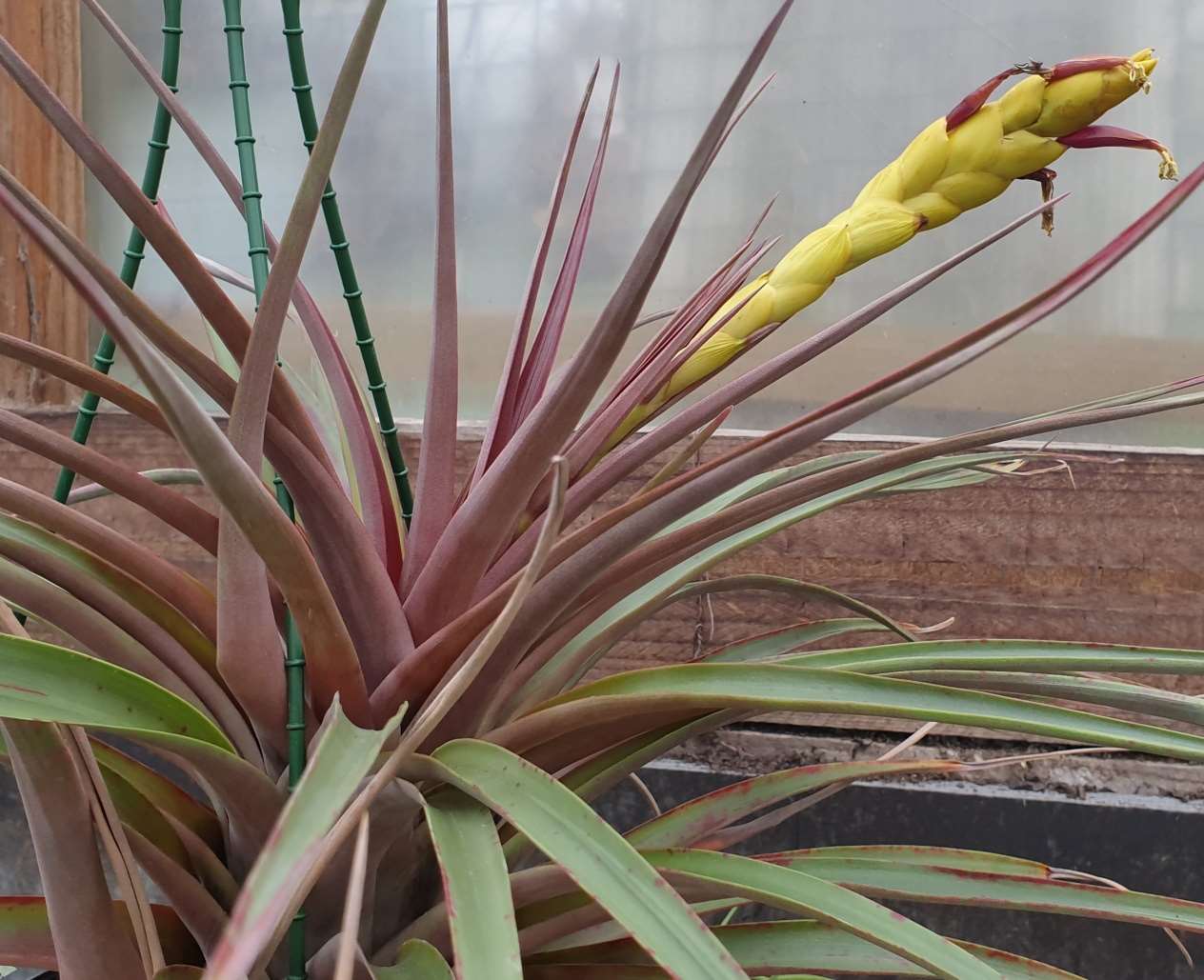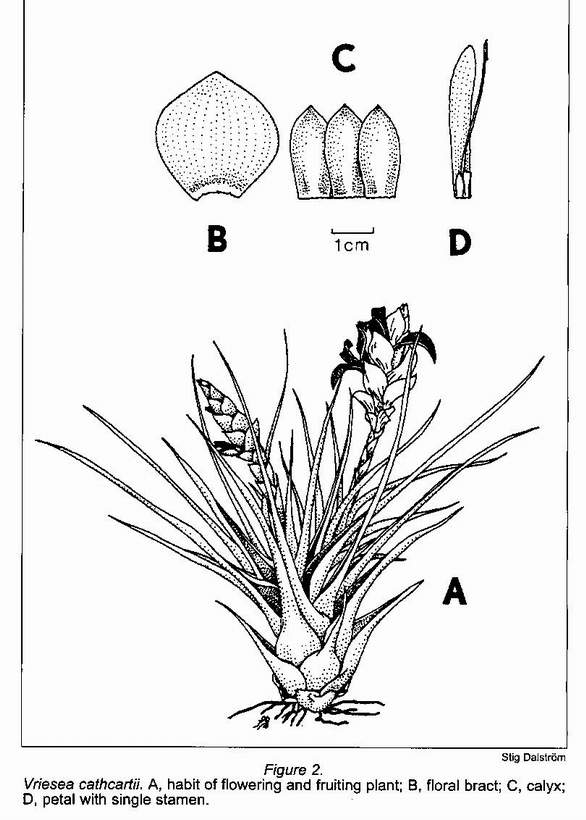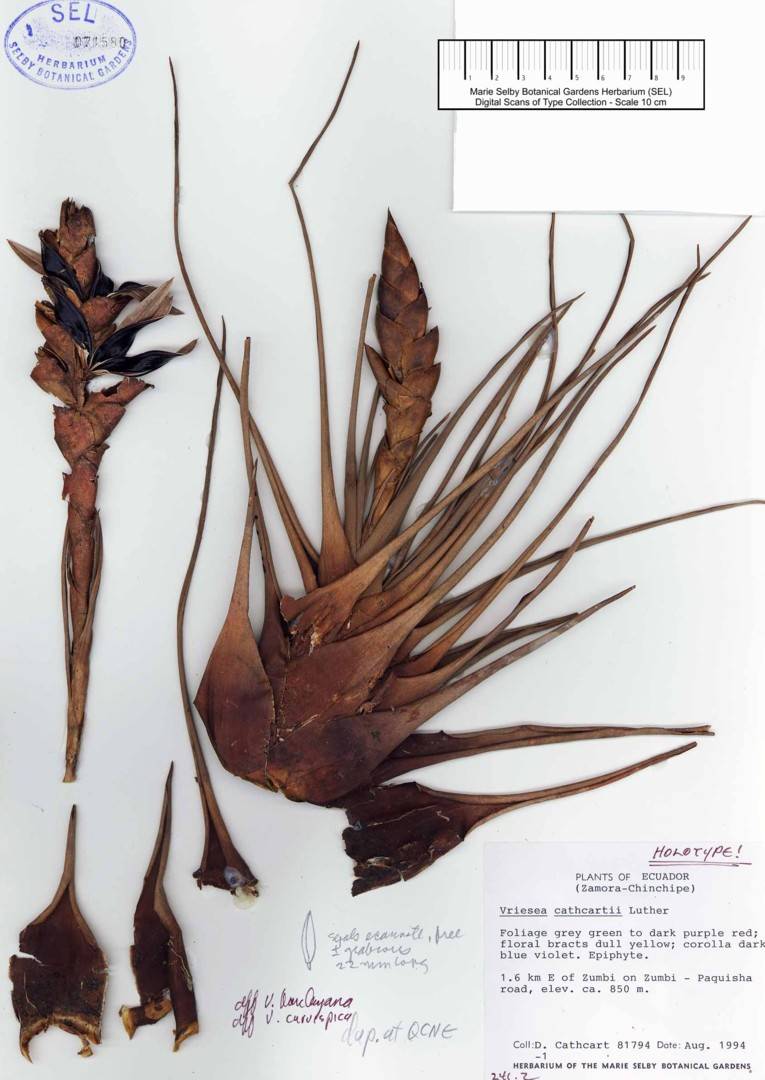



Plant an epiphyte, clustering, flowering 25-40 cm tall.
Leaves densely rosulate, erect to spreading, 30-40 in number, 20-30 cm long, stiff, coriaceous, grey-green to entirely red-purple.
Leaf sheaths broadly elliptic to ovate, 6- 7 x 4-5 cm, somewhat inflated, dark castaneous except at the extreme base, densely ferruginous lepidote.
Leaf blades narrowly triangular, 15-25 mm wide, acute to attenuate, pungent, channeled, densely pale punctate lepidote especially abaxially.
Scape erect, 5-14 cm x 4-5 mm, pale lepidote.
Scape bracts erect, imbricate, the lowest subfoliaceous, the upper broadly elliptic, exceeding and concealing the internodes, colored like the leaves.
Inflorescence erect, simple, narrowly elliptic, 6-10 x 2-3 cm, 6- to 12-flowered.
Rachis broad, excavated, white fimbriate lepidote.
Floral bracts tightly imbricate, ovate, acute, 28-32 x 25-30 mm, ecarinate, even, inconspicuously appressed punctate lepidote, rather lustrous, thin coriaceous, dull yellow becoming castaneous with age.
Flowers with a stout 2-3-mm-long pedicel.
Sepals free, oblanceolate, acute, 20-23 mm long, ecarinate but with a slight thickening at the base, glabrous, pale green.
Corolla with erect to slightly spreading lobes,
Petals ligulate, broadly acute, 36-38 x 5 mm, each with a pair of basal appendages 5-7 mm long, dark blue-violet.
Filaments unequal, white to pale blue, slightly shorter than the petals. Style white, stigma conduplicate-spiral with spreading lobes, equalling to exceeding the petals.
Fruit a dry capsule to 5 cm long.
Type. Ecuador: Zamora-Chinchipe, 1.6 km east of Zumbi on Zumbi-Paquisha road, e1ev. ca. 850 m; August 1994, D. Cathcart 81794-1 (SEL, holotype; QCNE. isotype).
Discussion of relationships.
Vriesea cathcartii differs from the Peruvian V. curvispica by having slightly shorter sepals (20-23 vs 25 mm), dull yellow (not green) floral bracts, dark blue-violet (not yellow-green) petals and a strictly erect (not arcuate) scape and inflorescence. In addition, the floral bracts of V. cathcartii appear far less lepidote (superficially glabrous) than do the bracts of V. curvispica due to the size and nature of the trichomes. The densely imbricate, ovate floral bracts immediately distinguish this new species from V. barclayana (Bak.) L.B. Smith and V. petrea (L.B. Sm.) L.B. Sm. which present a similar habit.
Vriesea cathcartii is a member of the "large-flowered-grey-Vriesea" complex. These have a center of diversity in the northern Andes with a few species occurring as far away as Cuba and Costa Rica. With single exception, (V. espinosae with sepals from 10-12mm long) sepal length of these species exceeds 15 mm and is generally around 20 mm. In contrast, the "small-flowered-grey-Vriesea" complex (Flower morphology of this complex is rather similar to species of Tillandsia placed in the subgenus Allardtia with the exception of the bi-appendaged petals of the majority of the species. They share with the "large flowered" complex, inflated, castaneous leaf sheaths.) has a slightly wider distribution (but still centered in the northern Andes), and sepals generally less than 12 mm in length. Neither of these complexes of species appears to be closely related to Vriesea sensu stricto of eastern South America.
Perhaps this new species and its relatives would be best placed in Tillandsia sensu stricto (Type: T. utriculata L.) as advocated by Grant (1993). However, until a thorough and thoughtful revision of Tillandsia and Vriesea based on a synthesis of morphological, molecular, distributional and ecological data is accomplished, I prefer to use the conservative and traditional (albeit artificial) generic concepts.